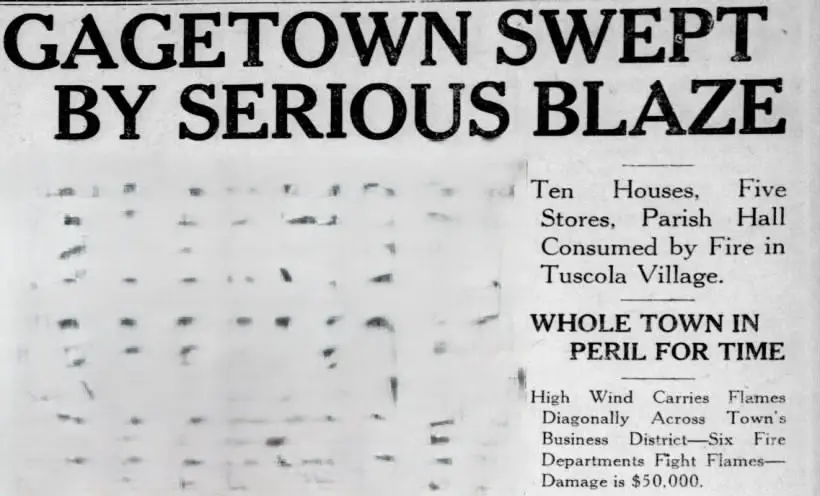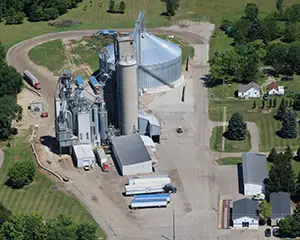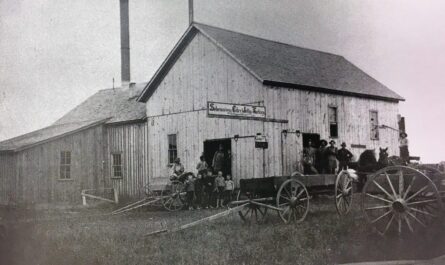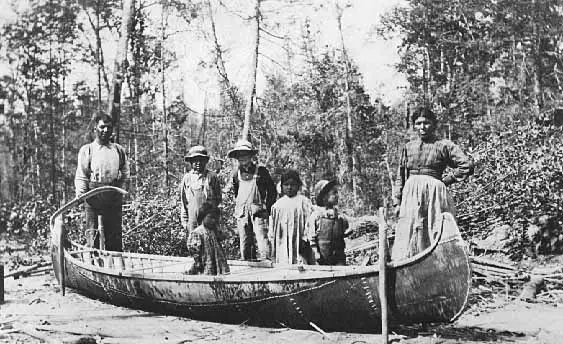A Village on the Map
Gagetown Michigan’s roots trace to Joseph Gage, who laid out the village plan and anchored it in Michigan’s Elmwood Township. The early plat map, dotted with the Gage family’s holdings, shows a town ready for growth — with a mill yard, State Street businesses, and farmland stretching to the horizon.
The Gagetown Michigan Grist Mill
The flour and grist mill at Gagetown was one of the earliest and most important industrial operations in the village. Built by James Gage, one of the town’s founders, the mill played a central role in local economic life in the late 1800s.
The first saw and grist mills in Gagetown were powered by Mill Creek, which was dammed to provide water power. This was a typical setup for small Michigan towns during that era, as waterpower was essential before the widespread arrival of steam and electricity. The original sawmill burned in 1877, part of a common cycle of industrial fires in 19th-century Michigan.
Gagetown survived the Great Thumb Fires of 1871 and 1881, which devastated much of Huron County, though the village itself escaped major losses aside from the mill. The mill’s operations were a vital service to local farmers, who brought in grain to be ground into flour or meal. It also anchored commerce by attracting related trades, such as blacksmiths, merchants, and teamsters who hauled products in and out.
Railroads and Harvests
By the early 1900s, Gagetown thrived as a rail town. The depot bustled with activity, shipping sugar beets, dairy, and goods to larger cities. Trains powered the economy, linking farmers to markets and bringing in supplies. Photographs show a scene of determined labor: horse-drawn wagons piled high with sugar beets, men loading milk cans at the depot, and a railway car labeled “Grand Trunk” waiting on the tracks.
A Community at Play
Gagetown was not just about work. Parade days brought the whole town together. Families gathered along Main Street to cheer floats and marching bands. Storefronts displayed local pride, with awnings pulled down against the summer sun. A lone man stands beside his horse and buggy, umbrella overhead, advertising a local merchant — a small symbol of the town’s character.
A Night of Flames

June 1925 marked a turning point. A fire sparked near St. Agatha’s parish hall quickly spread, leaping across streets and consuming buildings in its path. Ten houses, five stores, and the parish hall were lost. The town’s firefighting equipment failed under pressure, and only the arrival of neighboring fire departments stopped the blaze. The opera house and bank narrowly escaped the flames, standing as landmarks of survival.
Rebuilding For a New Generation

The site of the old Gagetown mill is now occupied by Vita Plus Corporation, a regional agribusiness that provides livestock feed and nutritional services to farmers. This continuation reflects Gagetown’s long-standing agricultural role in the Thumb. Vita Plus carries forward the land’s purpose — supporting Michigan’s farming community — even though the original wood-frame mill is long gone.
The history of Gagetown Michigan is also marked by the entrepreneurial spirit that led to the establishment of various businesses supporting the mill and the local community. Gagetown rebuilt from the ashes. The opera house continued to host events, and farmers returned to the fields. Main Street, once charred, resumed its rhythm. Today, old maps, photos, and family stories preserve Gagetown’s past — a past marked by hard work, close ties, and a shared determination to carry on.
A Final Nap About Gagetown Michigan
The Randall brothers’ mill stood as more than a structure — it was a working part of Gagetown’s economy, supporting farmers and shaping daily life in Michigan’s Thumb. Though the original building is gone, its role lives on through Vita Plus, which now occupies the same ground. From grinding grain to advancing livestock nutrition, the site continues to serve the same purpose it did in 1881 — supporting agriculture and sustaining a community built on hard work.
Throughout the challenges faced, Gagetown Michigan remained resilient, showcasing the strength and unity of its residents.



